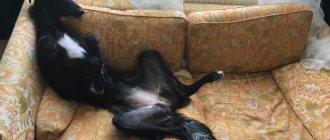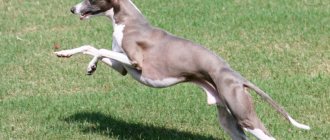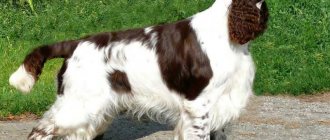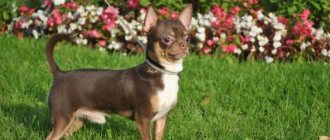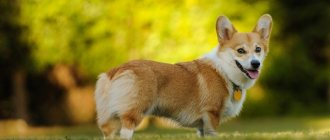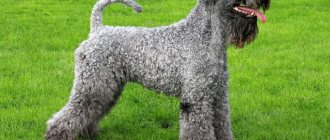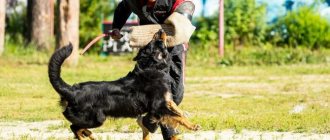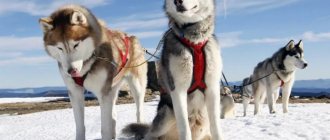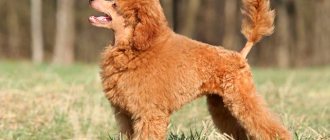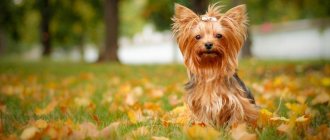If you were looking for a description of the dog breed known as the Russian Borzoi (or simply Russian Borzoi), then you have come to the right place. This article contains information about the appearance, character and habits of this aristocratic dog.
You can pay attention to how to care for it, what to use it for and how to feed it - this will help you in caring for your pet. This is if you are the happy owner. If you are still thinking about buying a puppy, then be sure to read the section “How to choose a puppy.” Also look at photos of the Russian Greyhound, admire its elegance and make an informed decision.
Dossier
Adult height: the male is on average 75 cm (can reach up to 85 cm), and the female is 66 cm (up to 75 cm). Weight: from 35 to 50 kg. Characteristic color: white, white with a golden tint, cream, black, red (different shades). Coat length: long, wavy. Life expectancy: 10 – 12 years. Advantages of the breed: peaceful character, aristocratic appearance, hunting instinct. Difficulties of the breed: difficult to care for, prone to digestive problems, not suitable for everyone. The average price for a Russian greyhound: with a pedigree of at least $1500, without a pedigree $300-600. Classification: large breed; hunting, sports, companion.
Description of the breed
The Russian Greyhound has the following qualities: it has an elongated head (due to this structure of the skull it has extensive vision) and a body with a lean belly. The nose is long with large nostrils and a small hump.
The dog is quite tall: knots at the withers reach 68-78 cm, males - 76-86 cm. Representatives of Russian greyhounds are endowed with good eyesight. A powerful jaw with developed white teeth allows you to firmly hold prey. Scissor bite or straight bite.
The breed has a medium chest width. The saber-shaped tail is slightly raised upward during movement. The ears are thin, small, located high on the top of the head close to each other. Long croup with well-developed muscles, more than 8 cm wide. Paws are even, straight, narrow with powerful, strong nails.
The Russian Greyhound is a sprinter. In just a few seconds it can accelerate to a speed of 100 km/h. But the animal is able to maintain the pace of the chase for no more than 20 seconds. During this time, it covers a distance of 600-700 meters. Then the body overheats and the muscles lose their elasticity.
The usual speed during a chase is 60 km/h. This is a powerful, active dog, despite its elegance. The greyhound is characterized by duality: calm and peaceful at home, it becomes aggressive on the hunt, sensing prey. She is a hunter only during a certain working period, and the rest of the time she is a calm and affectionate pet. Today, greyhounds take part in the sport of greyhound racing after an artificial hare.
Greyhound colors vary:
- - white;
- - fawn;
- - piebald;
- - murugi (the main color is reddish-red, and the muzzle and ends of the ears are black; a black stripe may be present on the back and body)
- — gray (in various shades);
- - black;
- — burmatny/dark burmatny (from light fawn to red-fawn/with brown awn).
Colors may include inclusions consisting of white spots. The color can be piebald, that is, with white spots on various parts of the body and limbs, and spotted, with dark spots.
Origin story
The first mentions of greyhounds date back to the middle of the 16th century. In 1650, a standard for this breed was written. There are several theories about the origin of greyhounds. According to one, the representatives of the breed are the descendants of huge dogs with which boar were hunted in Rus'. According to another, greyhounds are the result of crossing a Russian hound and a Finnish dog.
The greyhound is the dog of the aristocracy. The emperors themselves kept several personal dogs at court. It was impossible to buy a puppy; they were not for sale. Therefore, such a gift was considered incredibly expensive. Even in Europe, dogs of this breed appeared there only after the Russian emperor presented two puppies to the Queen of England, and then to other monarchs of European states.
After the October Revolution, greyhounds were destroyed as “master’s dogs”; only a few were saved. Since the 1930s the breed began to be restored. However, even today it is a very rare breed. The price of a Russian greyhound, even in our time, is fabulous.
History of the breed
A hunting breed, these are companion dogs. They were first mentioned in the 17th century. Russian greyhounds were valued for their hunting qualities - they developed high running speed and drove their prey into a corner. It reaches 60 km/h and accelerates to 100 km/h in a jerk. The Russian greyhound gets its name from the word psovina - a wavy, silky coat.
Interesting Facts:
- In Kyiv, on a fresco of the St. Sophia Cathedral (6th century), there is an image in which a dog with a long muzzle and a thin body was chasing a deer. It is believed to be a representative of the Coetzi.
- Dog hunting was Vasily III's favorite pastime. The Coetzis deftly pursued the game. They are fast and brave, however, for pursuit they chose the prey that runs the slowest.
- In the 16th century, Ivan the Terrible resettles the Tatars to Kostroma and Yaroslavl. Here Asian greyhounds mix with local hunting dogs and end up in Poland as Slovenian dogs. The Coatzi crossed with large local dogs, resulting in the Russian Greyhound breed in the second half of the 16th century.
Boris Godunov sent several Russian greyhounds to Shah Abbas. In those days, dogs were very expensive and such a gift was a sign of respect.
In the 18th century, representatives of the breed began to be crossed with immigrants from England and the Baltic states. There is an opinion that the ancestors of Russian greyhounds belong to the Laika breed. In 1888, a breed standard was developed and established. In Russia, every wealthy gentleman was required to have at least one greyhound. The richest could afford a pack.
Thanks to the improvement of relations between Russia and the Baltic states, the Russian dog mixed with the Baltic Brudasta (Courland dog). This is how the Courland Greyhound appeared, which subsequently disappeared. Russian hunters intended to breed a more worthy breed. A new Kurland has emerged.
In the 19th century, the Russian dog came to England and was adopted by members of the English royal family. In the 20-30s of the 20th century, the breed was in great demand; dogs were even featured in commercials.
The profile of the Russian Borzoi adorns the emblem of the Russian Canine Federation, although it is a rare breed in Russia.
In parallel with the development of the canine in Eastern Europe, the formation of the smooth-haired greyhound breed is taking place.
How to choose a puppy
Russian greyhound puppies, like all children, are restless, but in comparison with other breeds they are calmer. Before adopting a puppy, you should decide why you need it and whether you can keep it. How much a Russian greyhound puppy costs depends on its pedigree, living conditions and purity of the breed.
Make your choice:
- If you have a small apartment, an allergy to wool and little time for a dog, you absolutely should not get a greyhound.
- If you plan to attend exhibitions, competitions or take part in hunting, then you need to choose puppies with a good pedigree and from trusted breeders.
- If you just need a friend, then you can buy an inexpensive puppy, but still make sure that the baby is vaccinated and healthy.
Breed standard:
- The body is elongated.
- Smooth narrowing of the body towards the head.
- The head is wedge-shaped.
- The chest is extended towards the forelimbs.
- The wool is luxurious and silky.
- The tail is set low.
Breed characteristics
Size
Large
Need for activity
Lots of physical loads
Dominance
Moderate
Child Compatible
Only with older children
Difficult to care for
Periodic care
Guard qualities
Can warn of danger
Learning ability
Easy to learn
Independence
Not particularly dependent
Friendliness
Reserved
Noisiness
Barks for warning
Shedding level
Constantly shedding
Contents in the apartment
Only if there is a physical
load It is worth keeping in mind that each dog is individual. This description is specific to the breed as a whole, so it may not match the description of your dog. How an animal will behave depends largely on its owner, and not on the breed. If you can't decide on a dog breed, we recommend that you use our online dog breed selection tool.
Care and maintenance
- Accommodations . The greyhound is not a small dog, so, unfortunately, it will not be possible to keep it in a small apartment. It is ideal if the animal lives in a house with an area where it can frolic. In this case, the area should be well fenced so that the dog does not jump over the fence. By the way, despite the long hair, the greyhound will not be able to live on the street - it does not have an undercoat.
- Bathing . Infrequent. Dogs of this breed are neat - they will not roll around in the mud. You need to bathe no more than 1-2 times a month.
- Grooming . Constant. The coat is long, so it requires brushing at least 1-2 times a week. Greyhounds are susceptible to shedding, especially in the fall. Then you need to comb your pet every day.
- Fight against lice and fleas. As with any long-haired dog, these parasites can stick quickly and for a long time. The owner’s responsibility is to comb out tangles (the main breeding grounds) and apply special products (collars, creams, sprays, shampoos). However, you should be very careful, because this breed is prone to allergies to certain medications.
- Caring for your eyes, ears and teeth . Teeth should be brushed every day, ears should be washed as needed, and it is very important to check the eyes, as the Greyhound breed is prone to some eye diseases.
Training and education
Despite the ever-increasing number of cities, hunting does not lose its popularity. The success of greyhounds, including Russian hounds, is connected with this. When getting a pet, it is important to know whether it will be used for its intended purpose. This is one of the important criteria for successful interaction with a dog.
Already from puppyhood, the greyhound is taught to respond to the trumpet signal, which is given during the hunt. But first it is used while feeding the baby. Then the puppy is taught to be patient - he should not touch the food until the owner gives the command. These are important aspects in developing discipline.
Without proper exercise, the dog loses its abilities and gains excess weight, so it is important to provide it with regular long walks with mandatory activity. During training, it is worth remembering the nuances of this breed; it is important to give the pet basic skills, as well as special commands that will simplify socialization. The dog must distinguish between when the hunting process is going on and when it comes to everyday issues. It is advisable to take a special training course from a professional.
If there are domestic animals on the farm, it is important to immediately accustom the new pet to it so that it does not hunt them later. In any case, you should behave calmly and restrained during training, and in no case use physical force.
Training
Representatives of the breed are quite difficult to train. Due to their breeding qualities (hunting instinct, stubbornness, leadership), greyhounds can hardly stand being commanded. Therefore, the main principle of training is partnership, but with obligatory human leadership. Here you need to show patience and self-confidence.
Important! It is imperative to socialize your pet from early childhood. The more communication a dog has with other animals and people, the more appropriate its behavior will be in the future.
Character
The character of the Russian greyhound is soft, calm, and balanced. They have the grace of a model. Excellent vision and lightning-fast reactions allow them to be unique hunters. The breed is hardy: they can hunt in various conditions for a long time.
They treat strangers with arrogance and indifference. She has a neutral attitude towards pets with whom she was raised together. The rest can be perceived as prey. Well suited for keeping in an apartment. The fur does not have a specific “dog” smell, sheds lightly, and produces a voice exclusively “in a business-like manner.”
He behaves in the likeness of a cat: he loves warm places near radiators, and is invisible in the apartment. Since the animal needs constant activity and physical activity, it is recommended to walk it at least twice a day. To keep the muscles toned, the greyhound needs a regular run of 6-12 km.
Limiting physical activity can lead to depression. The Russian greyhound does not need training, but rather mutual understanding with the owner. When contact is established between the owner and the dog, mutual respect emerges with trust on the part of the dog and understanding “at a glance.” Love and care are very important for a greyhound. The dog is balanced, but it is better to keep it on a leash when walking.
Advantages and disadvantages
Each dog breed has a number of advantages and disadvantages.
Advantages of the breed:
- Very strong and hardy animals. Fast and brave.
- A strong hunting instinct - an ideal dog for a practicing hunter.
- A faithful friend and a wonderful companion.
- Aristocratism and tranquility.
- Rare breed.
Disadvantages of the breed:
- Difficult care.
- Picky eating.
- Tendency to certain diseases of the breed (retinal atrophy, allergies, food problems).
- They react poorly to some medications (primarily anesthetics).
Tell me, do you like Russian greyhounds, would you like to have such a pet? And if you already own such a puppy (or an adult dog), then share the secrets of training these stubborn dogs. Write in the comments, everyone will benefit from your opinion.
Education and training
It is necessary to educate and train representatives of this species. The hunters' impressive size, speed and fiery nature can lead to problems if not properly trained and trained. A calm and confident greyhound dog can suddenly become uncontrollable if it spots prey. To raise an active puppy into an aristocratic greyhound, you will need to spend an impressive amount of time and effort.
You can start socializing your dog as early as 3 months. At this age, it is enough to limit yourself to walks of 30-40 minutes, during which you need to carefully introduce the baby to other representatives of the “dog” society. The main task of the owner will be to “protect the psychological peace” of the pet. Avoid creating stressful situations, teach the animal to be a strong and confident representative of its species.
As for training, in the first six months of life, master walking on a leash and simple commands: “come to me,” “near,” “place,” “stand.” Gradually increase physical activity and walking time. If possible, try to walk with adult greyhounds from whom the puppy could learn the rules of behavior.
Avoid serious punishments. Russian greyhounds are very sensitive to rough training methods. Treat your puppy like a teenager, with all the challenges that come with that period of life. With a calm and balanced approach to training, the dog will quickly learn the rules.
From about one year of age, you can move on to planned training and preparation for hunting. At this time, walks with a young dog increase in duration to 3 hours. At the same time, monitor the animal’s well-being, do not overdo it. It is better to develop hunting instincts gradually and carefully.
Health
The average life expectancy of a Russian greyhound is 7-10 years. The owner is responsible for the health of the animal. It is he who must annually bring the dog to the veterinary clinic for preventive examinations, x-rays, and tests.
It is important to do routine vaccinations, treatment for skin parasites and deworming on time. Please keep in mind that representatives of the breed are very sensitive to many chemicals, including anti-flea and tick products.
It is necessary to carefully monitor the physical activity of puppies and young dogs during the period when intensive growth occurs. Excessive stress can lead to serious bone problems.
The Russian Greyhound breed can be called healthy with strong immunity. It should only be noted that she is predisposed to the following health problems:
- Volvulus – Greyhounds often suffer from bloating, in most cases this is due to the pet being overly active immediately after eating.
- Increased sensitivity to anesthesia and painkillers.
- Cataract is clouding of the lens, leading to poor vision.
- Wobbler's syndrome is compression of the cervical vertebrae.
- Cardiovascular diseases.
- Oncological diseases.
Breed standard
The breed standard was adopted in 1888. The authoritative greyhound breeder Ermolov contributed to this. Description of parameters:
- the head has an elongated muzzle, which does not interfere with a wide view of the area; the skull tapers towards the nose;
- jaws - have a scissor bite, which is also known as a pincer bite;
- teeth - strong, large, white;
- nose - with a black nose;
- eyes - beautiful, brown, almond-shaped;
- ears are small in size, set high, hanging down on the sides of the head, pressed tightly to it:
- the neck is strong, long and carries the same elongated, proudly set head;
- body - has a rectangular format, the muscle mass is dry, the stomach is sunken;
- limbs - long, the hind legs are longer than the front legs, which contributes to the development of high speed;
- tail - with pronounced guard hair, shaped like a saber;
- wool - has extraordinary softness and silkiness, can resemble a wave or be curly;
- color - comes in different colors, reddish or gray with dark stripes, reminiscent of brindle, sex with silver, other different shades, there are pure black and white greyhounds.
Important! Males at the withers should not be lower than 73 and higher than 88 centimeters, females 66 and 80 centimeters, respectively.
Greyhounds of different colors
Disqualifying faults
The main defect of the Russian greyhound is its cowardice; there are males of the same type as females. Defects also include a short or elongated body, excessively high or short legs, overly developed undercoat, underdeveloped feathers, wide forehead, overly developed cheekbones, wedge-shaped head, low set ears, horizontal croup, chicken breast, drooping abdomen, clubfoot, incomplete set of teeth.
Hunting with a Russian greyhound
Hunting with a Russian Borzoi
The Russian greyhound is an excellent hunter in the middle zone, with which you can hunt hares and foxes, as well as a wolf, with equal success. And the point here is not only in natural instincts and innate intelligence, but also in a special, linear set of paws, which allows the dog to sharply change the direction of movement, thereby ensuring lightning-fast capture of game. However, despite such obvious advantages of the breed, today's hunters often reject its representatives as pets of low production. The reason for this neglect lies in the fact that Russian greyhounds are often crossed with other hunting dogs, as a result of which the pursuit instinct in the offspring does not manifest itself clearly enough. In addition, not all owners understand that although hunting with a Russian greyhound is a seasonal affair, they will have to develop and hone their pet’s skills and abilities throughout their life. A dog that goes out for baiting twice a year and spends the rest of the time lying on the couch will definitely not overwhelm its owner with hunting trophies.
Russian greyhounds are short-distance runners. The optimal conditions for demonstrating the hunting talents of the breed are a treeless area up to 500 m long, although, as practice shows, for most animals a 200-300-meter acceleration is enough to catch the prey and present it to the owner. The innate impulsiveness of dogs also plays an important role in the success of the hunt: upon seeing an animal, the Russian greyhound switches from standby mode to race mode in a split second. If attempts to overtake the prey are unsuccessful, the dogs are able to repeat the failed forced march after a half-hour pause.
Russian greyhounds run after a hare
Preparing for the first hunt can be considered the training of a Russian greyhound to a pack collar. You can start lessons from the age of 6 months: the puppy must learn to walk in a group, without rushing ahead or trailing behind the pack. You can hunt a Russian greyhound for game as early as 10-12 months, but at first the animals are allowed to make no more than one pursuit attempt. Teenagers are not yet as hardy as individuals who have previously participated in hunting, and are easily overtired. It would be great if the owner took two puppies into the house at once, and it is not at all necessary that both were of the same breed. As they grow up and compete for the role of alpha male, they will try harder to prove themselves during training.
It is best to bait a teenager with a Russian greyhound against a wolf in the company of experienced dogs and their owners. But you can hunt a hare alone, and in general it is more advisable to start training young greyhounds to chase game with the “eared brethren”. Often during the first hunt, greyhounds cannot restrain themselves and tear a small animal into pieces, or even eat it before the owner arrives. This, of course, is not a reason to be upset, but it is still worth slightly reproaching your pet for such behavior. Moreover, if your student demonstrates such “success” in field tests, he will not receive a diploma.
Wolf hunting with a Russian greyhound. Artist Evgeny Aleksandrovich Tikhmenev (1869–1934)
Health and treatment
The vaccination schedule and timely deworming of the pet must be observed.
Tablets or suspensions for worms:
- piperazine adipate;
- pyrantel;
- fenbendazole;
- Praziquantel
The drugs are used both for treatment and for prevention. Infection with parasites is not dangerous for humans, but it brings suffering to the animal itself.
Greyhounds, especially at a young age, are susceptible to viral and infectious diseases that bring irreparable consequences to the body and can lead to disability.
The puppy receives the antibodies necessary to fight viruses from its mother's milk. Special serums protect the pet after weaning from its mother until the first vaccination, which should not be delayed. Repeated vaccination is carried out after changing teeth, at 7-8 months. They are given only to healthy animals with active behavior.
Expert opinion
Anna Abramenko
An avid dog lover. Experience in veterinary medicine since 2009.
Ask a Question
If the pet has lost its appetite, has purulent discharge from the eyes, extreme thirst, trembling, vomiting or diarrhea, the owner should immediately consult a veterinarian.
